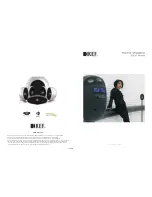
4
[SPEAKER INSTALLATION]
For proper connection and therefore full enjoyment of your new Phase Technology speakers,
we encourage you to read this owners’ manual thoroughly, even if you are very familiar with
installing speakers. Speaker placement is very subjective. Placement follows the guidelines for
the developers of in-ceiling speakers, yet is also guided by personal preferences. The proper
spacing, location and adjustment of in-ceiling speakers are critical for complete enjoyment of
your new speakers. This manual covers these topics thoroughly.
STEP 1
: Choose the appropriate mounting location for each speaker.
NOTE:
When deciding upon a location, consider the following:
• Be certain your speaker wires can be run to or are accessible from these locations.
• Make certain the wall or ceiling material is sturdy enough to support the weight and vibration
of the speakers.
• It is recommended that our pre-construction rough-in brackets
(part number RB-23)
be used
whenever possible in new construction.
• Be certain the area behind the speaker is free of obstacles such as wall studs, electrical wiring,
pipes, etc.
• Each speaker should be positioned properly, relative to the listening area for good coverage.
• Audio performance and room-to-room isolation will be improved if there is some fiberglass
insulation placed loosely behind the speaker.
STEP 2:
Using the supplied cutout template, carefully mark the area to be cut out. Using a
drywall knife or saw, cut a hole in the drywall and prepare the speaker wires for connection to
the speaker terminals.
STEP 3:
Loosen the baffle clamping screws on the speaker assembly
(Figure 1)
one turn (counter
clockwise) to release the clamp. Use a level to insure that the flange is square. Next tighten all 4
flange clamp screws evenly to secure the speaker assembly to the wall. It is best to tighten each
screw with the same amount of force (torque).
CAUTION: DO NOT OVER TIGHTEN.
STEP 4:
Connect the speaker wires to the spring loaded input terminals
(Figure 2)
on the rear
of the speaker, making sure no loose strands are exposed.
STEP 5:
Using some familiar source material, listen to the tweeter’s balance with the level
control in each of its three positions
(Figures 4A-4C)
to find your favorite tonal balance.
STEP 6:
Carefully replace the grille by pressing it onto the speaker.
(Figure 3)
The grille will snap
into place using magenets. Enjoy!
STEREO FIG. 4A
-8 ohms: Use this
configuration to drive one channel
(left
OR right)
of a stereo pair. Set jumper
plugs in the stereo position.
(Fig. 4A)
Connect the right or left signal wire to
the right set of terminals on the rear of
the speaker. Leave the front panel switch
in the Bipole position.
STEREO POINT SOURCE FIG. 4A-
8
ohms: Use this configuration to combine
left AND right
channels for full fidelity
sound from a single loud-speaker stereo
source
(Fig. 4A)
. Set jumper plugs in
the stereo position. Connect right and
left signal wires to the spring-loaded
terminals on the rear of the speaker.
Leave the front panel switch in the Bipole
position.
MONO/STEREO FIG. 4B-
4 ohms: Use
this configuration to drive one channel
(
left OR right
) of a stereo pair with a 4
ohm speaker load. Set jumper plugs in
the mono position.
(Fig. 4B)
Connect the
right or left signal wire to the left set of
posts on the rear of the speaker. Acoustic
output of the speaker is increased by 3
dB in this configuration.
BIPOLE/DIPOLE FIG. 4C-
4 ohms:
Use this configuration for home theater
surround applications. For
bipole
mode, connect as in the
Mono/Stereo
instructions (
FIG. 4C
): one speaker
to each surround channel. For
dipole
mode, connect speaker inputs the same
as
Mono/Stereo
instructions (
FIG. 4C
),
but reverse the
+
and
–
connections of
the red and black tweeter wires to put
one of the tweeters out of phase.
[FIG. 4A]
[FIG. 4B]
[FIG. 4C]
CLAMP
SCREW
[FIG. 2]
[FIG. 1]
[FIG. 3]
_
MONO
STEREO
STEREO
MONO
BIPOLE
DIPOLE
MOUNTING DEPTHS
CI20 X, CI70 X, &
CI-SURR X: 3.5” D
CUTOUT
DIMENSIONS
CI20 X, CI70 X,
& CI-SURR X:
11.375” H x
7.375” W
Содержание CI20 X
Страница 1: ...OWNER S MANUAL INSTALL GUIDE CI X SERIES CI20 X CI70 X CI SURROUND X ...
Страница 6: ......
























